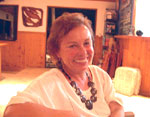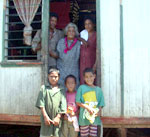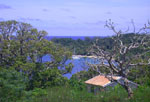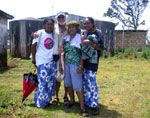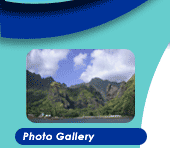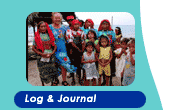September 25, 2002
|
Branches flailed against corrugated iron roofs. The wind rose like an approaching freight train, moaning through the shuttered windows and doors of the little village on the hill above Hunga Lagoon. Gusts of wind found their way into the homes of the huddled occupants, causing the flames of their kerosene lanterns to tremble and flicker. Whole lines of frangipani trees toppled over like a pile of dominoes, the angry wind having already torn away their leaves and flowers. The delicate flowers of the hibiscus trees had disappeared and now the branches were breaking. But that was only the beginning of Cyclone Waka’s fury this New Year’s eve. It is ironic that exactly two years after the joyous dancers of Tonga were seen on international television--the first to celebrate the New Millennium--the inhabitants of Tonga’s most beautiful and treasured island group, Vava’u, entered the year 2002 frightened and despairing. As the New Year began, the sea continued to slam against the shorelines, devouring anything in its path: trees were uprooted; docks destroyed; boats overturned; schoolhouses, churches, and hospitals ground to rubble. Even in the relatively protected harbor of Neiafu, a catamaran broke loose of its moorings and flew right into Ana’s Waterfront Café, where for some weeks after, the owners continued to carry on business around it. Most of the waterfront docks and structures had to be rebuilt. The governments of other countries, most notably French Polynesia, contributed workers and materials to rebuild schools and hospitals. Missions and charities rebuilt churches and handed out food necessary for survival. But for the inhabitants of Vava’u, there was no such thing as government aid to rebuild. Nine months later, they are still recovering. In Hunga, the villagers staggered drunkenly in the wind as their homes fell around them, the sand stinging their faces like icy sleet. They ran for cover to whatever dwelling was still standing, carrying a few meager possessions with them. Coconuts thudded on roofs and cisterns with the force of exploding cannonballs. Shade trees were uprooted and torn apart until none were left standing in the little village. Every gust of wind hurled more branches and debris until the landscape was flat. Then came the rains. Ugly, twisting ravines replaced tree-lined paths. As the villagers tried to rebuild out of the muddy mess, the sun came out and glared mercilessly on their barren and ugly world, with no protecting shade. “Afa” (the storm) was over; but during that time of misery, these villagers found it hard to believe that beauty would ever again come to Vava’u. The lush vegetation has returned to Vava’u. But we still see the after-effects of Cyclone Waka as we cruise through the beautiful islands here: uprooted trees, sawed-off tree trunks, piles of old and new wood, a few newly-constructed buildings, and many overturned boats and canoes still lining the shores and reefs of anchorages and lagoons. For the 80% or more here who live off the land, recovery is slow. For a coconut to grow from seed to bearing requires about ten years. And replanting immediately means using nuts that can be used immediately for food. Bananas do not bear until the following year. The most immediate crop is the papalangi (European) vegetables such as tomatoes, cucumbers, lettuce, string beans and cabbage, which we have been enjoying. These can be produced quickly and sold at the market in Neiafu, in return for nails and building materials. The sea, of course, is full of fish, another source of income. We have enjoyed all the bounty that Vava’u has to offer for over a month now. We have purchased fresh produce at the market each time we return from the anchorages to port in Neiafu. We have feasted our eyes on the lush landscapes, sandy beaches and colorful rock formations of the islands. And we swam and snorkeled in the emerald green waters of the lagoons and beaches. By the time we arrived at the Ika Lahi Gamefishing Lodge in Hunga Lagoon, and had enjoyed a very nice seafood dinner there, Gunter and I felt that we wanted to give back. I wasn’t sure how to go about it. We had experiences with giving to chiefs or village matriarchs in the past, and found out later that our gifts were not distributed to the families and children. I consulted with the New Zealand proprietress at the Lodge. She also had negative experiences involving distribution. One of her Lodge vacationers, a doctor from New Zealand, had given a box of medical supplies to the clinic in the Village: hundreds of dollars worth that should have lasted the little village an entire year. Yet a few days later, a villager came asking at the resort for a tube of antiseptic cream. It turns out that the nurse at the clinic had sent the box to his family in Nuku ‘alofa, where the supplies had been sold! So much for the Tongan communal culture described in the Guide Books. Perhaps this culture is declining, or perhaps it is limited only to family. “Can I just walk house-to-house up there?” I asked her. “Hmmm,” she answered. “You could if you had someone to point out the needy families to you…I know! I’ll ask Moule to accompany you after her shift. She is done working at the lodge by noon. She herself comes from a family of nine, and they could use some help.” “Her family would be perfect for our unopened box of 96 servings of Idaho potato flakes that we have on board,” I smiled. Now we were getting somewhere! She introduced me to Moule, who said that she would think through who the needy families might be. I agreed to dinghy back to the Lodge when she called to pick her up. When we came back, she had enlisted the help of her two Tongan friends, who also worked at the Lodge and lived in the Village. We distributed the tins of food, clothing, soap, shampoo and cosmetics into carrying bags and backpacks so that the five of us could carry them, then dinghied to the villages’ broken down pier. Then we trudged up the worn foot path to the village under the heat of the afternoon sun. The first stop was already worth the entire journey. I made my introductory speech and Moule translated to those who did not understand English. “We travel and live on a boat called Pacific Bliss. We are moored in your very beautiful Hunga Lagoon. You are blessed with such wonderful Nature here. Because your lagoon has given us so much pleasure, we want to give back to your village. We understand that your village suffered a horrible cyclone and that it will take a long time to recover. So we want to help by giving you some small food and gifts.” I explained how to use the potatoes from Idaho and we let each of the family members choose a Tee-shirt from our bag. Then I passed out cosmetics and soaps to the women. They all laughed as they held up a petite princess-waist dress. “Who here would fit into this?” Gunter joked. “Not any of us!” The second stop was a widow whose children had left Vava’u. She lived alone in a small one-room shack. We gave her plenty of tins along with her Zip-lock-enclosed gift of soaps and shampoos. “I’ll begin to eat this today,” she said, holding up the can of chicken breast and smiling. Our next stop was the home of a man whose leg had been crushed in an accident. He could not move, so we were invited in. As with most of the homes we visited, his home consisted of one room with bedrolls for everyone to sleep and a main room, with no furniture, just mats on the floor and the meager possessions hung from the rafters or on nails pounded into the walls. At the next house, we decided to give the wizened old grandmother plenty of soup as she smiled her wide, toothless grin. “You chose the eight needy families well,” said Gunter turning toward Moule as we walked from home to home on bare ground interspersed with tufts of grass. There was no landscaping, no bushes with flowers. It was the poorest, most desolate village I have ever seen. Solitary cement cisterns sat where there must have been houses with the typical corrugated roofs catching the rain. Barbed fences surrounded some properties. Other had broken wooden gates that we easily climbed over to approach the house. “But I’m still concerned how you will find someone to fit into the small dress,” he added as we tramped along. “I know of a lady who has a small daughter,” Moule laughed. This turned out to be the only stop where the recipient—even after my speech—said, “But I don’t have anything to give you in return.” We planned the packages of clothing, food, and gifts so that by the last stop, our bags were empty, except for special gifts of nail polish and costume jewelry for the girls who had helped us so cheerfully. As they walked us down the hill back to our dinghy, we told them again how we truly appreciated the beauty of Vava’u and the friendliness of the Tongan people. Truly, it is more blessed to give than to receive. A special thanks to each of you who contributed clothing and gifts at our Bon Voyage Party. Richard: your bag of Tee-shirts is finally distributed. Markus and Sabine: your clothing went to good use. The Mowers family: the children loved the coloring books, colored paper and crayons. And Chris and Jana, your donation was used to buy 25 pounds of flour and 10 pounds of sugar to be distributed to these eight needy families. Photos: Lois at Ika Laki Lodge
journal90.html |
|
|
|
